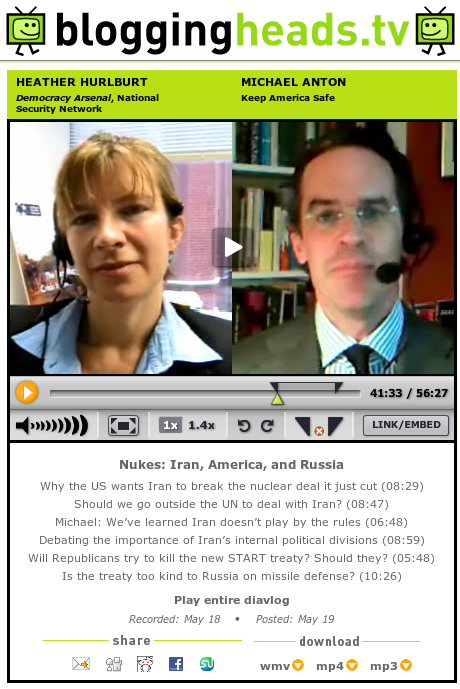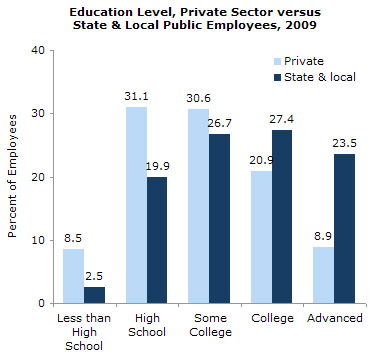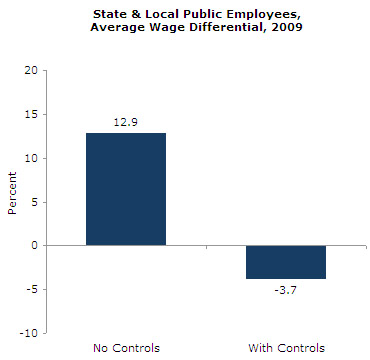Archive: May 2010
Now 40 percent faster!
May 22, 2010
Bloggingheads.tv is the site that lets you watch hour-long one-on-one video chats between a pretty big selection of bloggers, columnists, journalists, scientists, lawyers, and other internet hipsters.

Some of the chats feature like-minded people going back and forth (Ross Douthat and Reihan Salam or Michelle Goldberg and Rebecca Traister). Others are online cage matches (Dean Baker and Megan McCardle or Glenn Greenwald and Lawrence Lessig (OK, well maybe I exaggerate)).
The format gives a nice feel for the personal styles of people who I generally only know through their writing. Something like the in-between-the-songs commentary you get at some live music events.
I also like the brief table of contents that appears just below the talking heads. It lets you skip to what look to be the most interesting bits.
And the feature I like most is that bloggingheads gives the option to run the video at 1.4 times the normal speed. Everyone is still completely understandable, but an hour goes by in about 43 minutes.
What About the Benefits?
May 13, 2010
My CEPR report released yesterday shows that state-and-local government workers earn less than private-sector workers at the same age and education level. But what happens when we also include benefits? A second CEPR report, also released yesterday, addresses the benefits question.
Perhaps surprisingly, factoring in benefits doesn't much alter the conclusions. First of all, state-and-local workers are older (by about four years) and much better educated (just over half have a four-year college degree or more, compared to just under 30 percent of private-sector workers). Since we expect older, better-educated workers to have better benefits than younger, less educated workers, higher average benefit costs are not, in and of themselves, evidence that state-and-local workers' benefits are "too high".
Second, in the limited cases where we have evidence on (1) occupations that are broadly similar between the state-and-local and private sectors and (2) total wages and benefits, the sum of wages and benefits are actually pretty similar across the two sectors. Managers in state and local government, for example, have slightly lower wages and slightly higher benefits than their private-sector counterparts, leaving average compensation for managers almost identical across the two sectors.
Third, the private sector benefit numbers include a lot of small and medium-sized establishments, which frequently have poor benefits and are not a sensible point of comparison for state and local governments, which are often among the largest employers in their areas. National survey data on pay and benefits consistently show state-and-local government compensation packages (the sum of pay and benefits) are on a par with what large employers in the private sector offer.
Fourth, state-and-local pension expenditures are not directly comparable with private-sector numbers because 30 percent of state-and-local employees are excluded from Social Security. That exclusion means that an important portion of total state-and-local pension contributions goes only to make up for the missing Social Security.
Finally, solid state-and-local benefits packages may simply reflect market realities. Even the highest-skilled workers in the public sector will never get rich. They have no stock options, no big bonuses, no chance to become an equity partner or the CEO. Job security and good benefits are among the few ways to recruit and retain highly skilled public employees.
UPDATE 05/14/2010: In their recent study of state-and-local employee compensation, economists Keith Bender and John Heywood conclude that, even after factoring in benefits, state-and-local employees earn about seven percent less than similar workers in the private sector (and about 10 percent less than similar workers in large firms in the private sector).
Pay Penalty for State and Local Workers
May 12, 2010
Recent reports in the media have suggested that public-sector employees earn more than workers in the private sector. The problem with these analyses is that state-and-local government workers are older and have much higher levels of formal education than workers in the private sector. In a new CEPR report released today, I show that when state-and-local employees are compared to private-sector workers with similar characteristics (same age, same level of education, same state), the state-and-local workers actually earn 4 percent less, on average, than their private-sector counterparts.
This graph shows the differences in education levels between state-and-local and private-sector employees. Just over half of state-and-local workers have a four-year college degree or more, compared to just under 30 percent in the private sector.

And this graph shows the effects of controlling for these age and education differences. Without controls, state-and-local workers look to make about 13 percent more than private-sector workers. But once we factor in the older, better-educated workforce in the state-and-local sector, the pay premium turns into a four percent pay penalty.

CEPR also released a second, related report today, on benefits paid to state and local workers. More on that tomorrow.
UPDATE 06/07/2010: Holly Yeager at the Columbia Journalism Review's Campaign Desk ("politics, policy, and the press") cited the report in a post commenting on a piece by Ben Smith and Maggie Haberman in today's Politico.
On June 1, the New York Times Economix blog posted one of the graphs from the report. The graph that caught their eye showed state-and-local public employees as a share of all employees in each state. As the post noted: "It appears that more conservative states --which we traditionally think of as wanting smaller government-- nonetheless have a higher share of their work force employed by the public sector."